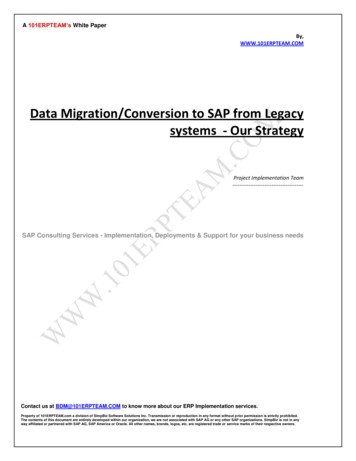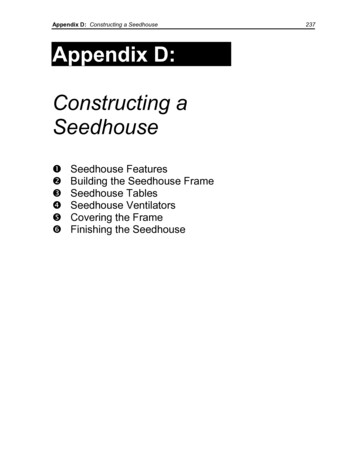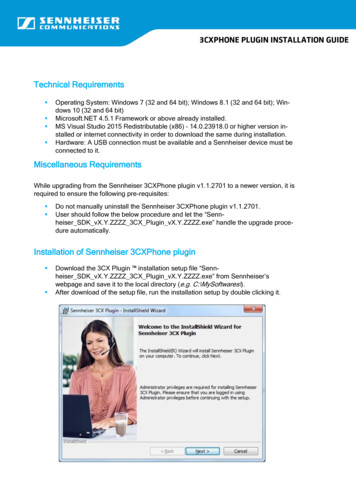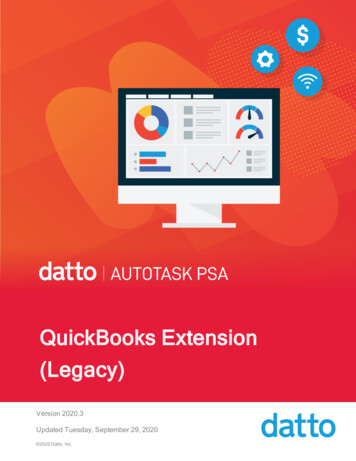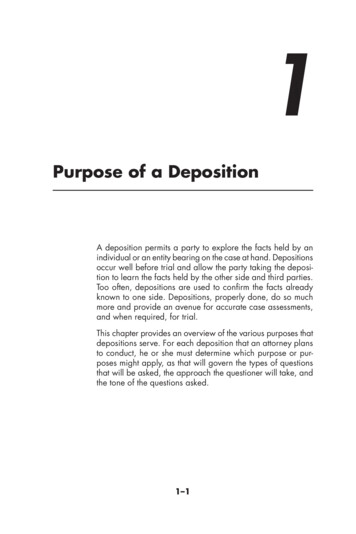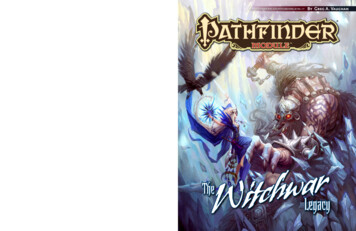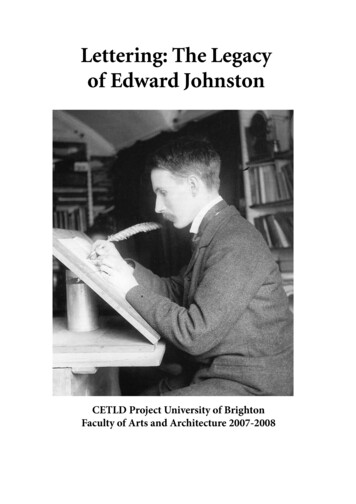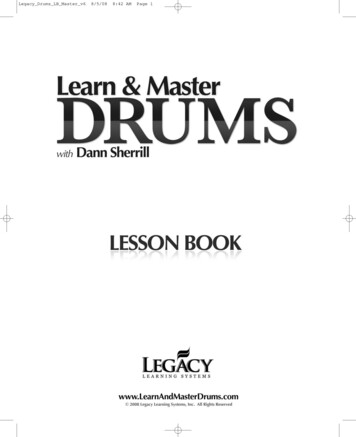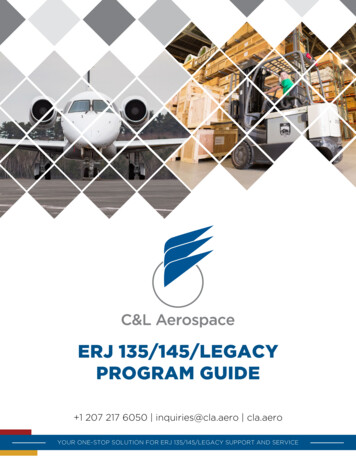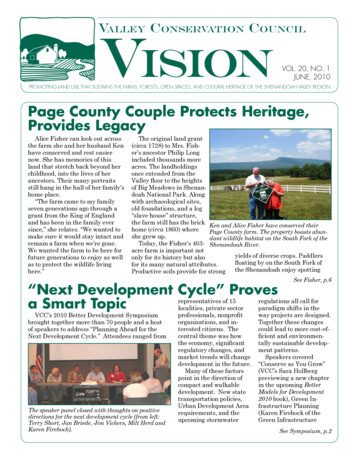
Transcription
Functional RequirementsAppendix #:Subject:09Legacy Migration RequirementsAppendix 9 – Legacy MigrationOverview . 2General Information – Legacy Migration . 3Response to Procurement Enhancement Requirements . 22See the RFP Section 1.2 and the Task Order Section 1.2 for a complete list of allabbreviations and acronyms.All requirements contain the word “shall” which may be part of the sentence containingthe requirement or precede a list of requirements.For requirements that contain a bulleted list, the bulleted list is provided for clarification,interpretation, reference, definition or example.TO# V-HQ-16025ITDIWS 2 TO - Appendix 09 - Legacy Migration RequirementsPage 1 of 26
Functional RequirementsAppendix #:Subject:09Legacy Migration RequirementsOverviewLegacy DIWS contains Operational Content and administrative content that must bemigrated to DIWS 2. The migration of the administrative content is discussed in: DIWS 2 TO Appendix 6 Functional Requirements: Accounts PayableDIWS 2 TO Appendix 7 Functional Requirements: Human ResourcesDIWS 2 TO Appendix 8 Functional Requirements: ProcurementMigration of the operational unstructured content is discussed herein.TO# V-HQ-16025ITDIWS 2 TO - Appendix 09 - Legacy Migration RequirementsPage 2 of 26
Functional RequirementsAppendix #:Subject:09Legacy Migration RequirementsGeneral Information – Legacy MigrationLegacy migration addresses the need to migrate content from the Legacy DIWS platformto the DIWS 2 ECM proposed by the Offeror. The following migration requirementsshall be addressed:Define the scope of the contentIdentify the content and the as-is index/attribute values to be migratedIdentify the to-be index/attribute valuesIdentify the unstructured content mapping rulesContent conversion rulesPerform unstructured content and index/attribute cleansingConfigure migration toolsIteratively perform unstructured content migration trial runsIteratively analyze the migrated unstructured content for completeness andcorrectnessExecute the final unstructured content migration for the production environmentValidate the final migrated unstructured content for completeness and correctnessArchive legacy the content2.1ProcessThere are no current unstructured content migration processes in Legacy DIWS formigrating Operational Content from the Legacy DIWS.For the DIWS 2 migration process, the Offeror shall:1.Propose a migration process that addresses the key activities necessary formigrating content from Legacy DIWS to the proposed ECM.2.Ensure the legacy migration is consistent with requirements defined in DIWS2 TO Appendix 5 Toolbox Requirements, section 6.6 Migration.TO# V-HQ-16025ITDIWS 2 TO - Appendix 09 - Legacy Migration RequirementsPage 3 of 26
Functional RequirementsAppendix #:Subject:09Legacy Migration Requirements3.Propose a process on how other vendors are to interact with the Contractor forrequesting:content to be migratedchanges to migration schedulessamples of content to be migrated for development or testingaccess to migration environments and non-migration environmentswhere migrated content is locatedaccess to interfaces for accessing migration environments and nonmigration environments where migrated content is locatedmigrated content to be made available in specific DIWS environmentsfor development or testingmigrated content to be made available in the production DIWSenvironmentssupport on accessing the environments where migrated content islocatedsupport on accessing migrated contentsupport on troubleshooting apparent problems with migrated contentproblems with migrated content to be fixed 4.Interaction with the Contractor for migration matters is expected to bethrough a formal process. The Project Core Vendor Personnel are goingto need access to migrated content, the environments where migratedcontent is located, and the interfaces for accessing migrated content. TheProject Core Vendor Personnel will also require assistance and support inaccessing migrated content and reporting problems with migrated content.Identify all tools that will be used for performing the migration activities,especially tools for automating the migration and for validating thecorrectness and completeness of the migrated content.For the DIWS 2 migration process, the Contractor shall:5.Perform fact-finding to determine all necessary information required toperform the legacy content migration.6.Work with the business areas to define the testing values for ensuring (a)100% of the unstructured content is migrated and (b) 100% of the attributesassociated with the unstructured content (after mapping) are migrated.7.Work with the business to agree on the details and best approach forperforming data cleansing.8.Work with the business to agree on the details and best approach forperforming data mapping.TO# V-HQ-16025ITDIWS 2 TO - Appendix 09 - Legacy Migration RequirementsPage 4 of 26
Functional RequirementsAppendix #:Subject:09Legacy Migration Requirements9.Propose the detailed process that addresses the key activities necessary formigrating content from Legacy DIWS to the proposed ECM. 10.11.This migration process is expected to be a refinement of the migrationprocess proposed by the Offeror based on fact-finding performed by theContractor.Present the migration process to the MVA for review.Work with the MVA and content consumers to address all comments andquestions on the migration process. 12.Content consumers tend to be business areas, but may be any person orgroup (e.g., a legacy system developer) that understands the content ormigration process.Confirm all tools that will be used for performing the migration activities,especially tools for automating the migration and for validating thecorrectness and completeness of the migrated content.13.This activity shall be a confirmation of the migration tools proposedby the Offeror based on fact-finding performed by the Contractor.Due to the significant quantity of content that must be migrated, themigration process shall be automated using tools appropriate formigration.Obtain approval for the migration process from the MVA.14.Prepare a schedule to implement the approved migration process.15.Obtain approval from the MVA Project Manager for the schedule toimplement the approved migration process.16.Execute the approved migration process according to the schedule, in amanner consistent with DIWS 2 TO Appendix 1 – ContractorResponsibilities & Duties: Project Execution.TO# V-HQ-16025ITDIWS 2 TO - Appendix 09 - Legacy Migration RequirementsPage 5 of 26
Functional RequirementsAppendix #:Subject:09Legacy Migration Requirements17.Provide the MVA Project Manager with the final processes rules defininghow the Contractor will perform the following tasks:Requesting disk storage in an environment for either staging contentfor migration or for migrating content into the ECM.Scheduling servers and other migration resources in an environment.Defining document/content types in an environment.Establishing rules for standing up an environment or server within anenvironment (including funding).Installing migration-related software in an environment.Promoting migrated content between environments (e.g., from the testenvironment to the production environment).Resolving conflicts between migration environments (e.g., storageconflicts, scheduling conflicts, content conflicts).Establishing the criteria for promoting migrated content into theproduction environment (e.g., first demonstrate successful migrationof content into a test or migration environment with zero errors).Identifying rules governing any other activity, resource or accessnecessary to maintain and promote effective unstructured contentmigration.Defining the process for altering the rules when required.2.2Document/ Content TypesThe Legacy DIWS system has a robust set of document/content types containing a largenumber of attributes. Most of the attribute information for each document/content typewill be migrated to DIWS 2, along with unique identifiers and some additional attributevalues. For example: Many of the existing document/content types may be extended to include an identifierfor customer, business, vehicle or other entities. There may be a unique identifier provided by the external system that allows for fastaccess to the content.For the DIWS 2 migration document/content type activities, the Contractor shalliteratively apply all rules listed below as many times as needed to perform asuccessful migration of the unstructured content and attributes associated with eachbusiness area:1.Identify the legacy document/content types and associated index/attributessubject to migration in each business area.TO# V-HQ-16025ITDIWS 2 TO - Appendix 09 - Legacy Migration RequirementsPage 6 of 26
Functional RequirementsAppendix #:Subject:09Legacy Migration Requirements2.3.Work with the business areas to identify changes to the document/contenttypes including, but are not limited to:Renaming document/content types.Combining document/content types.The addition or removal of attributes associated with adocument/content type.Redefining existing attributes (e.g., data type, validation, mandatory).Define rules for mapping the legacy (as-is) document/content types attributesto the to-be document/content types.Rules may include, but are not limited to:4.a. Copying the attribute values without change.b. Mapping the existing attribute values to new valuesc. Splitting attribute values across multiple attributesd. Inserting unique values into the attributese. Inserting business area-supplied values into the attributesf. Validating attribute values against an MVA-supplied table of values.Create one or more unique identifier(s), as specified by the content consumer,for all content that shall ensure the content is able to be retrieved in the mostrapid manner possible while ensuring enforcement of all applicable accessrules and restrictions. For example, a document might be retrieved by specifying four attributesthat uniquely identify the document, or by specifying a unique identifier.However, the unique identifier is optimized to provide a retrieval rate thatis 0.10 seconds faster than specifying four attributes.The primary content consumer for the Operational Content identified inSection 2.6.1 Content Inventory and Section 2.6.2 Extrinsic ContentMigration Concurrence, is Project Core. Project Core is expected torequire and/or provide a unique identifier (or a rule(s) for calculating aunique identifier) for all content that it requires access to. This uniqueidentifier should allow the Project Core applications to retrieve contentusing the interfaces defined in Appendix 10 in a highly optimized manner.The unique identifier is in addition to the other attributes used to index theunstructured content.The actual manner in which a content consumer may specify one or moreunique identifiers will be determined by the content consumer. Theserules are all related to SQL calculations that typically involve a sequencenumber, a date/time, and/or some existing database fields.TO# V-HQ-16025ITDIWS 2 TO - Appendix 09 - Legacy Migration RequirementsPage 7 of 26
Functional RequirementsAppendix #:Subject:09Legacy Migration Requirements5.Define rules for converting the legacy (as-is) unstructured content to the to-beunstructured content.Rules may include, but are not limited to:6.2.3a. Creating thumbnail images.b. Converting unstructured content from one format to another format(e.g., TIFF to PDF)c. Converting multi-image files to multiple single-image files.d. Converting multiple single-image files to a single multi-image file.e. Validating successful content conversion.Ensure all unstructured content is able to be retrieved using thedocument/content types and values agreed to.7.Define rules for performing data cleansing and ensuring clean content.8.Obtain approval for the initial to-be document/content types from the MVAProject Manager.9.Obtain approval for the initial rules to-be document/content types from theMVA Project Manager.10.Define and/or update the to-be document/content types and associatedattributes in DIWS 2.11.Export the legacy (as-is) document/content type attribute values and thecorresponding to-be attribute values, as an electronic list, to the MVA.12.Obtain any changes to the to-be attribute values from the MVA.13.Configure the rules in the migration tool for mapping the legacydocument/content types and attributes to the to-be document/content typesand attributes.14.Validate the correctness of the rules in the migration tool for mapping thelegacy document/content types to the document/content types.User InterfacesNo user interfaces for migration from Legacy DIWS have been identified at this time.NOTE: Additional user interfaces may be added as a result of the requirementsverification activities and design activities.TO# V-HQ-16025ITDIWS 2 TO - Appendix 09 - Legacy Migration RequirementsPage 8 of 26
Functional RequirementsAppendix #:Subject:2.409Legacy Migration RequirementsReportsFor migration reports and data extracts are necessary for working with the business areasin (a) identifying the content that must be migrated, (2) identifying the rules for migratingthe content, and (3) reporting on the success of the migration.For the DIWS 2 migration reporting activities, the Contractor shall:1.Produce reports and extracts that consistent with requirements defined inDIWS 2 TO Appendix 5 Toolbox Requirements, section 4.8 Reports andQueries.2.Produce an electronic report in human readable format that identifies theattributes of all content that is subject to migration for each business area. 3.4.Although it is unlikely a human would read one or more reports thatcontain(s) information on nearly 300 million docu
Migration of the operational unstructured content is discussed herein. TO# V-HQ-16025IT -Appendix 09 Legacy Migration Requirements Page 2 of 26 . DIWS 2 TO Functional Requirements Appendix #: Subject: 09 Legacy Migration Requirements General Information – Legacy Migration Legacy migration addresses the need to migrate content from the Legacy DIWS platform to the
